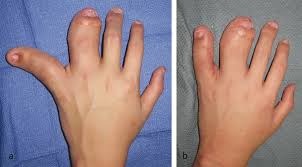
Over View
What is macrodactyly?
Macrodactyly is an uncommon condition in which a baby's toes or fingers are abnormally large due to the overgrowth of the underlying bone and soft tissue. Macrodactyly is not cancerous. However, the larger fingers or toes (digits) may make it hard for your child to use the affected hand or foot for certain activities.

What are the symptoms of macrodactyly?
When macrodactyly is progressive, the affected digits grow faster than the rest of the hand. If your child has static macrodactyly, their affected fingers or toes will generally be about one-and-a-half times the length and width of the unaffected digits. If their condition is progressive, the involved fingers or toes can become enormous.
What causes macrodactyly?
Macrodactyly can occur in association with other conditions and syndromes, including:
- neurofibromatosis
- vascular malformations
- multiple enchondromatosis
- tuberous sclerosis
- Maffucci syndrome
How is macrodactyly diagnosed?
Your child’s doctor probably will see signs of macrodactyly soon after your child is born. However, if your child has the progressive kind, it may not be detected right away. Your child will have an x-ray and may have an MRI (magnetic resonance imaging) of their hand or foot to provide more information about the enlarged tissues.
How is macrodactyly treated?
The goal of treatment is to ensure your child’s hand has the most function and best appearance possible.
In mild cases, treatment may involve watching your child’s hand carefully over time.
In more severe cases, your child’s doctor may recommend surgery. Unfortunately, there is no simple procedure for thinning and shortening the affected fingers or toes since all parts of the digits (bones, tendons, nerves, blood vessels) are larger than normal.